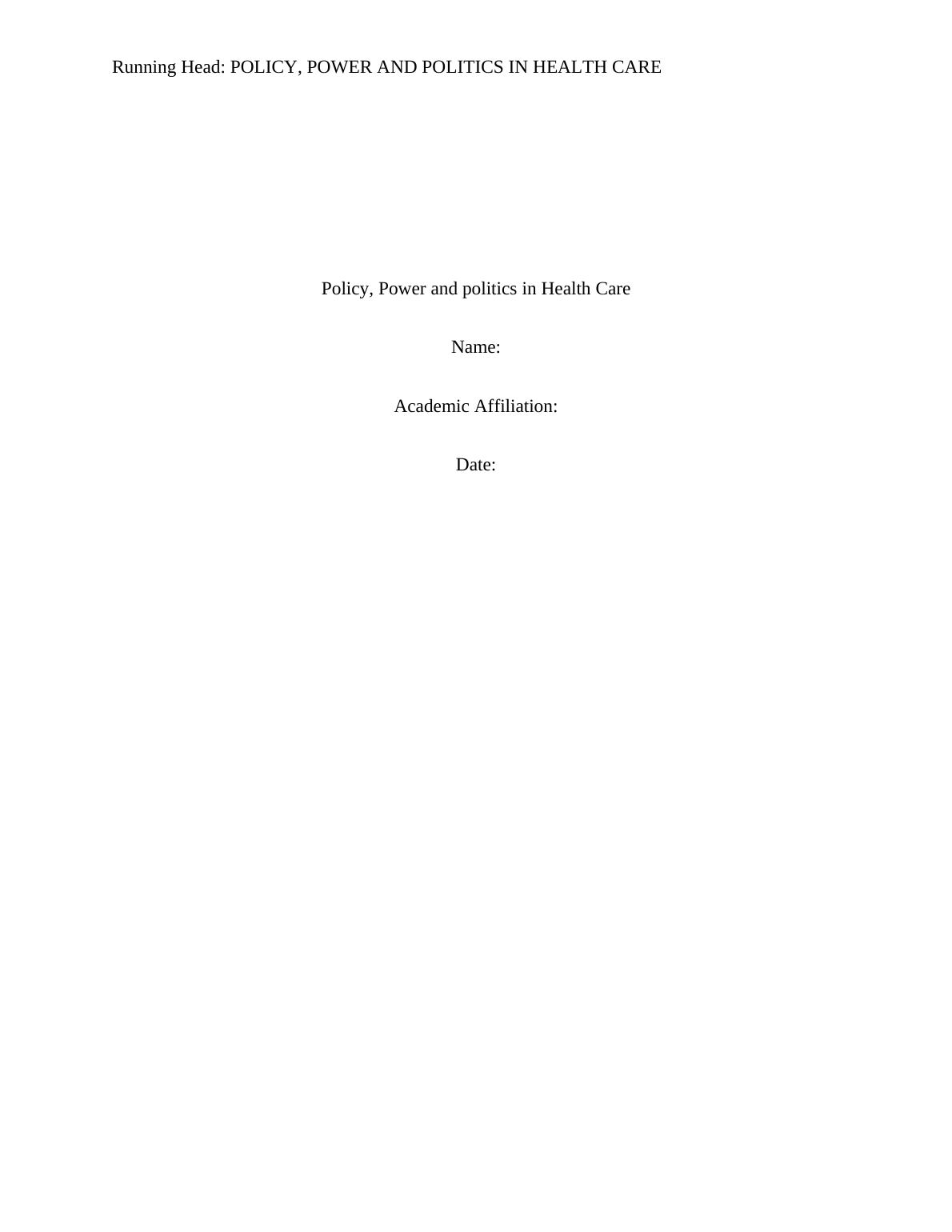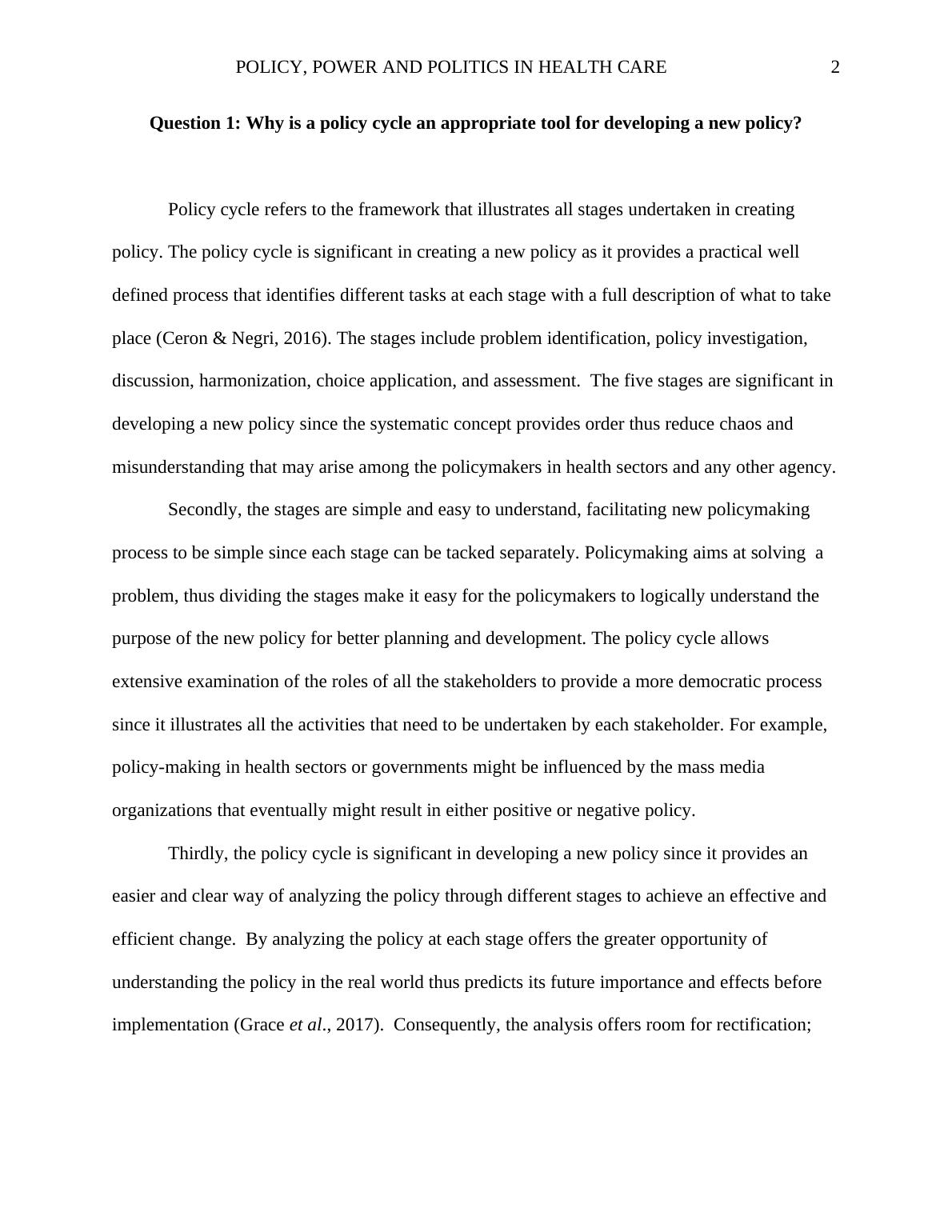Policy, Power and Politics in Health Care
Added on 2023-01-09
9 Pages2285 Words94 Views
Running Head: POLICY, POWER AND POLITICS IN HEALTH CARE
Policy, Power and politics in Health Care
Name:
Academic Affiliation:
Date:
Policy, Power and politics in Health Care
Name:
Academic Affiliation:
Date:

POLICY, POWER AND POLITICS IN HEALTH CARE 2
Question 1: Why is a policy cycle an appropriate tool for developing a new policy?
Policy cycle refers to the framework that illustrates all stages undertaken in creating
policy. The policy cycle is significant in creating a new policy as it provides a practical well
defined process that identifies different tasks at each stage with a full description of what to take
place (Ceron & Negri, 2016). The stages include problem identification, policy investigation,
discussion, harmonization, choice application, and assessment. The five stages are significant in
developing a new policy since the systematic concept provides order thus reduce chaos and
misunderstanding that may arise among the policymakers in health sectors and any other agency.
Secondly, the stages are simple and easy to understand, facilitating new policymaking
process to be simple since each stage can be tacked separately. Policymaking aims at solving a
problem, thus dividing the stages make it easy for the policymakers to logically understand the
purpose of the new policy for better planning and development. The policy cycle allows
extensive examination of the roles of all the stakeholders to provide a more democratic process
since it illustrates all the activities that need to be undertaken by each stakeholder. For example,
policy-making in health sectors or governments might be influenced by the mass media
organizations that eventually might result in either positive or negative policy.
Thirdly, the policy cycle is significant in developing a new policy since it provides an
easier and clear way of analyzing the policy through different stages to achieve an effective and
efficient change. By analyzing the policy at each stage offers the greater opportunity of
understanding the policy in the real world thus predicts its future importance and effects before
implementation (Grace et al., 2017). Consequently, the analysis offers room for rectification;
Question 1: Why is a policy cycle an appropriate tool for developing a new policy?
Policy cycle refers to the framework that illustrates all stages undertaken in creating
policy. The policy cycle is significant in creating a new policy as it provides a practical well
defined process that identifies different tasks at each stage with a full description of what to take
place (Ceron & Negri, 2016). The stages include problem identification, policy investigation,
discussion, harmonization, choice application, and assessment. The five stages are significant in
developing a new policy since the systematic concept provides order thus reduce chaos and
misunderstanding that may arise among the policymakers in health sectors and any other agency.
Secondly, the stages are simple and easy to understand, facilitating new policymaking
process to be simple since each stage can be tacked separately. Policymaking aims at solving a
problem, thus dividing the stages make it easy for the policymakers to logically understand the
purpose of the new policy for better planning and development. The policy cycle allows
extensive examination of the roles of all the stakeholders to provide a more democratic process
since it illustrates all the activities that need to be undertaken by each stakeholder. For example,
policy-making in health sectors or governments might be influenced by the mass media
organizations that eventually might result in either positive or negative policy.
Thirdly, the policy cycle is significant in developing a new policy since it provides an
easier and clear way of analyzing the policy through different stages to achieve an effective and
efficient change. By analyzing the policy at each stage offers the greater opportunity of
understanding the policy in the real world thus predicts its future importance and effects before
implementation (Grace et al., 2017). Consequently, the analysis offers room for rectification;

POLICY, POWER AND POLITICS IN HEALTH CARE 3
thus required changes can be made at earlier stages to facilitate the success and achievable of the
goals.
Question 4: Key sociological issues and how do they determine a person’s state of health
Sociological issues refer to the problems or aspect that are perceived by society to be
harmful to the members’ life and needs intervention and remedy strategies. Numerous
sociological issues affect the lives of the societies, and these entail:
Nutritional diseases- nutritional diseases have been rampant over the past decades. The
rate of contraction of Diseases such as obesity, hypertension, cancer and diabetes mellitus have
increased over the past years due to poor eating habits that are facilitated by easy access to poor
nutritional foods. These disease results in increased global death rate, for example, ischemic
Heart disease, stroke, and Lower respiratory infections result in 15.5%, 11.1% and 5.6% of all
deaths respectively (Meloni, Williams & Martin, 2016).
Lack of education- inadequate education is high in most of the pasts, especially in
underdeveloped countries. Statistics show that only about 6.7% of the global population has a
college degree and two third of African students tend to lack the opportunity to gain secondary
education. The high rate of education lack leads to a high level of health disparities. Most of the
uneducated individuals are unable to read thus making them have difficulty in knowing the
harmful food items, poor health behaviors and how to deal with such negative nutritional effects,
thus leading high rate of nutritional disease among them.
High rate of unemployment- there has been an increasing global unemployment rate and
underemployment over the past decades and mostly affects the developing countries. Both
unemployment and underemployment in developing countries rates at 30 % (Ott, Rosenberger,
McBride & Woodcox, 2011). This ultimately affects the purchasing power of the people, leading
thus required changes can be made at earlier stages to facilitate the success and achievable of the
goals.
Question 4: Key sociological issues and how do they determine a person’s state of health
Sociological issues refer to the problems or aspect that are perceived by society to be
harmful to the members’ life and needs intervention and remedy strategies. Numerous
sociological issues affect the lives of the societies, and these entail:
Nutritional diseases- nutritional diseases have been rampant over the past decades. The
rate of contraction of Diseases such as obesity, hypertension, cancer and diabetes mellitus have
increased over the past years due to poor eating habits that are facilitated by easy access to poor
nutritional foods. These disease results in increased global death rate, for example, ischemic
Heart disease, stroke, and Lower respiratory infections result in 15.5%, 11.1% and 5.6% of all
deaths respectively (Meloni, Williams & Martin, 2016).
Lack of education- inadequate education is high in most of the pasts, especially in
underdeveloped countries. Statistics show that only about 6.7% of the global population has a
college degree and two third of African students tend to lack the opportunity to gain secondary
education. The high rate of education lack leads to a high level of health disparities. Most of the
uneducated individuals are unable to read thus making them have difficulty in knowing the
harmful food items, poor health behaviors and how to deal with such negative nutritional effects,
thus leading high rate of nutritional disease among them.
High rate of unemployment- there has been an increasing global unemployment rate and
underemployment over the past decades and mostly affects the developing countries. Both
unemployment and underemployment in developing countries rates at 30 % (Ott, Rosenberger,
McBride & Woodcox, 2011). This ultimately affects the purchasing power of the people, leading

End of preview
Want to access all the pages? Upload your documents or become a member.
Related Documents
Policy, Power & Politics in Health Care Provisionlg...
|7
|2641
|50
Policy, Power, and Politics in Health Carelg...
|7
|2374
|375
Policy, Power and Politics in Health Carelg...
|9
|2090
|272
Policy Power and Politics in Health Care Provisionlg...
|9
|1892
|229
Policy, Power and Politics in Health Care Provisionlg...
|9
|2321
|1
Policy, Power, and Politics in Health Care Provisionlg...
|8
|2287
|85
